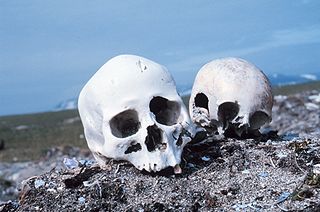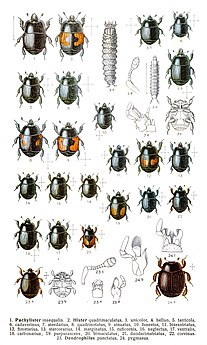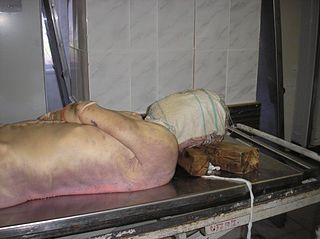
Forensic entomology is the scientific study of the invasion of the succession pattern of arthropods with their developmental stages of different species found on the decomposed cadavers during legal investigations. It is the application and study of insect and other arthropod biology to criminal matters. It also involves the application of the study of arthropods, including insects, arachnids, centipedes, millipedes, and crustaceans to criminal or legal cases. It is primarily associated with death investigations; however, it may also be used to detect drugs and poisons, determine the location of an incident, and find the presence and time of the infliction of wounds. Forensic entomology can be divided into three subfields: urban, stored-product and medico-legal/medico-criminal entomology.

Decomposition is the process by which organic substances are broken down into simpler organic matter. The process is a part of the nutrient cycle and is essential for recycling the finite matter that occupies physical space in the biosphere. Bodies of living organisms begin to decompose shortly after death. Animals, such as worms, also help decompose the organic materials. Organisms that do this are known as decomposers. Although no two organisms decompose in the same way, they all undergo the same sequential stages of decomposition. The science which studies decomposition is generally referred to as taphonomy from the Greek word taphos, meaning tomb.
Putrefaction is the fifth stage of death, following pallor mortis, algor mortis, rigor mortis, and livor mortis. This process references the breaking down of a body of a human or animal post-mortem. In broad terms, it can be viewed as the decomposition of proteins, and the eventual breakdown of the cohesiveness between tissues, and the liquefaction of most organs. This is caused by the decomposition of organic matter by bacterial or fungal digestion, which causes the release of gases that infiltrate the body's tissues, and leads to the deterioration of the tissues and organs. The approximate time it takes putrefaction to occur is dependent on various factors. Internal factors that affect the rate of putrefaction include the age at which death has occurred, the overall structure and condition of the body, the cause of death, and external injuries arising before or after death. External factors include environmental temperature, moisture and air exposure, clothing, burial factors, and light exposure.

Forensic anthropology is the application of the anatomical science of anthropology and its various subfields, including forensic archaeology and forensic taphonomy, in a legal setting. A forensic anthropologist can assist in the identification of deceased individuals whose remains are decomposed, burned, mutilated or otherwise unrecognizable, as might happen in a plane crash. Forensic anthropologists are also instrumental to the investigation and documentation of genocide and mass graves. Along with forensic pathologists, forensic dentists, and homicide investigators, forensic anthropologists commonly testify in court as expert witnesses. Using physical markers present on a skeleton, a forensic anthropologist can potentially determine a victim's age, sex, stature, and ancestry. In addition to identifying physical characteristics of the individual, forensic anthropologists can use skeletal abnormalities to potentially determine cause of death, past trauma such as broken bones or medical procedures, as well as diseases such as bone cancer.
A body farm is a research facility where decomposition can be studied in a variety of settings. They were invented by anthropologist Dr. William Bass in 1981 at the University of Tennessee in Knoxville, Tennessee where Dr. Bass was interested in studying the decomposition of a human corpse from the time of death to the time of decay. The aim is to gain a better understanding of the decomposition process, permitting the development of techniques for extracting information such as the timing and circumstances of death from human remains. Body farm research is of particular interest in forensic anthropology and related disciplines, and has applications in the fields of law enforcement and forensic science. By placing the bodies outside to face the elements, researchers are able to get a better understanding of the decomposition process.
Post-mortem interval (PMI) is the time that has elapsed since a person has died. If the time in question is not known, a number of medical/scientific techniques are used to determine it. This also can refer to the stage of decomposition of the body.

Histeridae is a family of beetles commonly known as Clown beetles or Hister beetles. This very diverse group of beetles contains 3,900 species found worldwide. They can be easily identified by their shortened elytra that leaves two of the seven tergites exposed, and their elbowed antennae with clubbed ends. These predatory feeders are most active at night and will fake death if they feel threatened. This family of beetles will occupy almost any kind of niche throughout the world. Hister beetles have proved useful during forensic investigations to help in time of death estimation. Also, certain species are used in the control of livestock pests that infest dung and to control houseflies. Because they are predacious and will even eat other Hister beetles, they must be isolated when collected.
Cadaveric spasm, also known as postmortem spasm, instantaneous rigor, cataleptic rigidity, or instantaneous rigidity, is a rare form of muscular stiffening that occurs at the moment of death and persists into the period of rigor mortis. Cadaveric spasm can be distinguished from rigor mortis as the former is a stronger stiffening of the muscles that cannot be easily undone, as rigor mortis can.
Transient evidence is term used in criminal forensics to indicate elements of physical evidence that might be expected to degrade or disappear within a particular time frame. As such, it is one of the five primary categories of physical evidence codified in Legal Medicine by the American College of Legal Medicine, along with conditional evidence, pattern evidence, transfer evidence and associative evidence. While, in a sense, many types of evidence degrade with the passage of time, the term is specific to factors with an inherently limited period of existence. A bloodstain itself is not transient evidence, despite its mutable nature. The condition and appearance of that bloodstain at a given point of time would, however, be transient evidence.

Skeletonization refers to the final stage of decomposition, during which the last vestiges of the soft tissues of a corpse or carcass have decayed or dried to the point that the skeleton is exposed. By the end of the skeletonization process, all soft tissue will have been eliminated, leaving only disarticulated bones.
Medicolegal entomology is a branch of forensic entomology that applies the study of insects to criminal investigations, and is commonly used in death investigations for estimating the post-mortem interval (PMI). One method of obtaining this estimate uses the time and pattern of arthropod colonization. This method will provide an estimation of the period of insect activity, which may or may not correlate exactly with the time of death. While insect successional data may not provide as accurate an estimate during the early stages of decomposition as developmental data, it is applicable for later decompositional stages and can be accurate for periods up to a few years.
The University of Tennessee Anthropological Research Facility, better known as the Body Farm and sometimes seen as the Forensic Anthropology Facility, was started in late 1971 by anthropologist William M. Bass as a facility for study of the decomposition of human remains. It is located a few miles from downtown Knoxville, Tennessee, USA, behind the University of Tennessee Medical Center.
In forensic entomology, entomotoxicology is the analysis of toxins in arthropods that feed on carrion. Using arthropods in a corpse or at a crime scene, investigators can determine whether toxins were present in a body at the time of death. This technique is a major advance in forensics; previously, such determinations were impossible in the case of severely decomposed bodies devoid of intoxicated tissue and bodily fluids. Ongoing research into the effects of toxins on arthropod development has also allowed better estimations of postmortem intervals.
Arpad Alexander Vass is a research scientist and forensic anthropologist. He is also a teaching associate with the Law Enforcement Innovation Center, which is part of the University of Tennessee's Institute for Public Service.

Body identification is a subfield of forensic science wherein investigators need to identify a body. Forensic purposes are served by rigorous scientific forensic identification techniques, but these are generally preceded by simply asking bystanders or other persons for the victim's name.
Carrion insects are those insects associated with decomposing remains. The processes of decomposition begin within a few minutes of death. Decomposing remains offer a temporary, changing site of concentrated resources which are exploited by a wide range of organisms, of which arthropods are often the first to arrive and the predominant exploitive group. However, not all arthropods found on or near decomposing remains will have an active role in the decay process.
Corpse decomposition is the process in which the organs and complex molecules of a human body break down into simple organic matter over time. In vertebrates, five stages of decomposition are typically recognized: fresh, bloat, active decay, advanced decay, and dry/skeletonized. The rate of decomposition of human remains can vary due to environmental factors such as temperature, humidity and the availability of oxygen, as well as body size, clothing and the cause of death.





